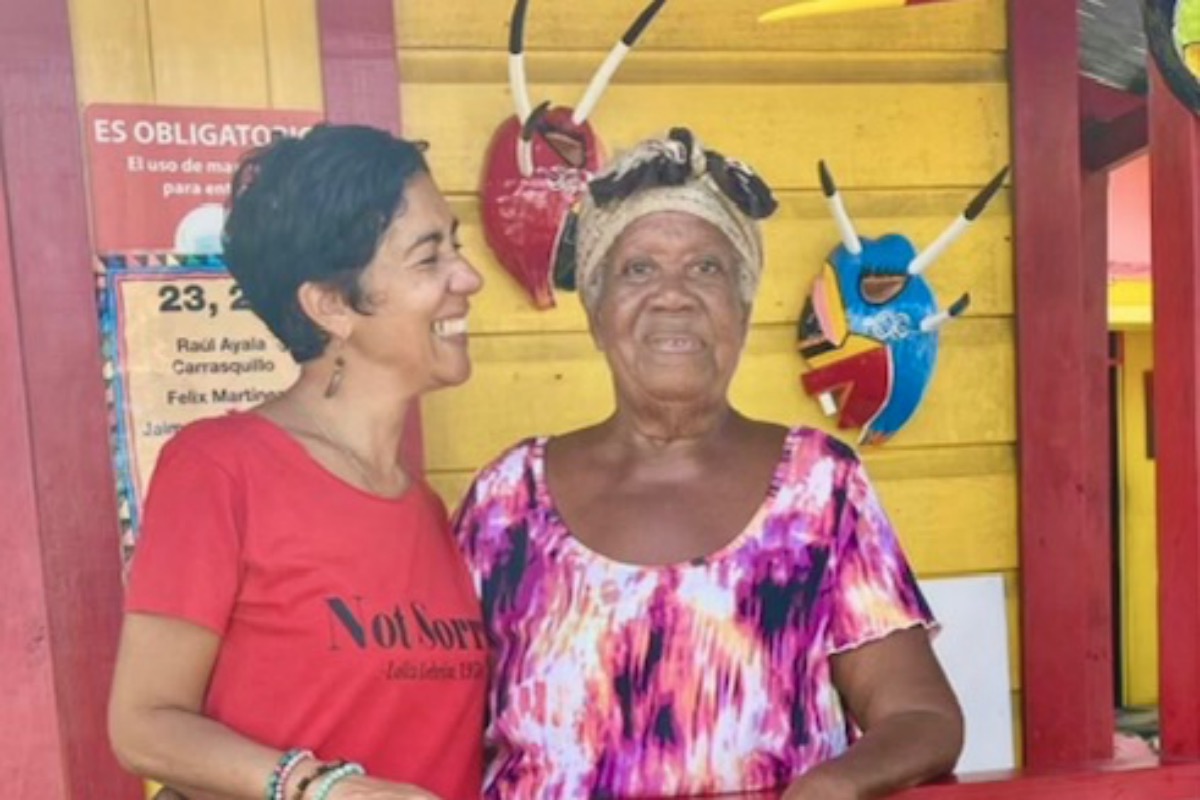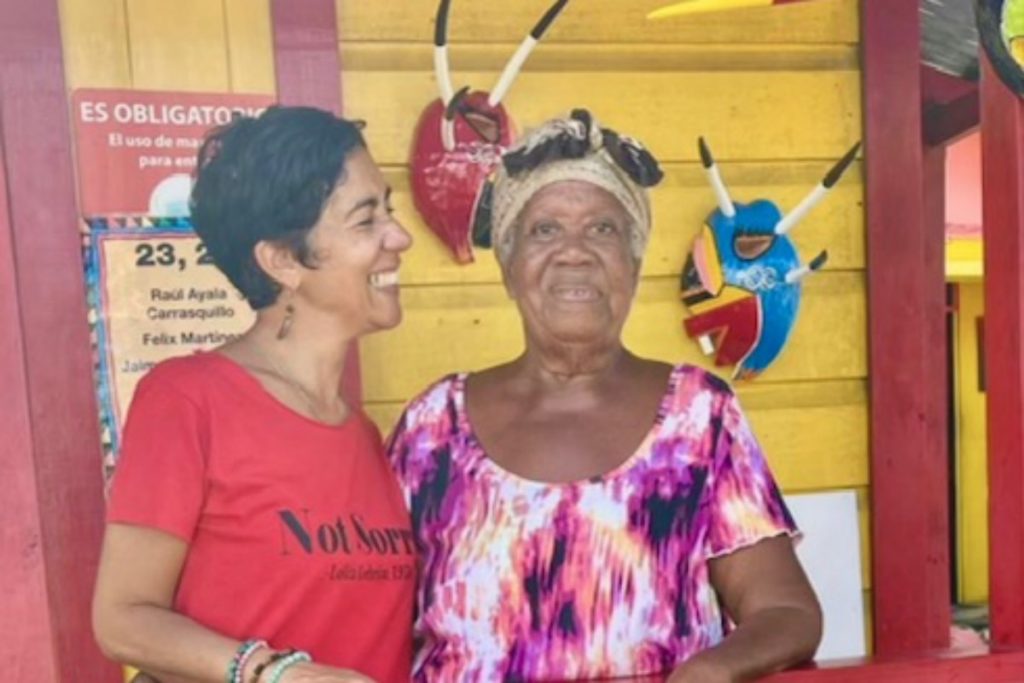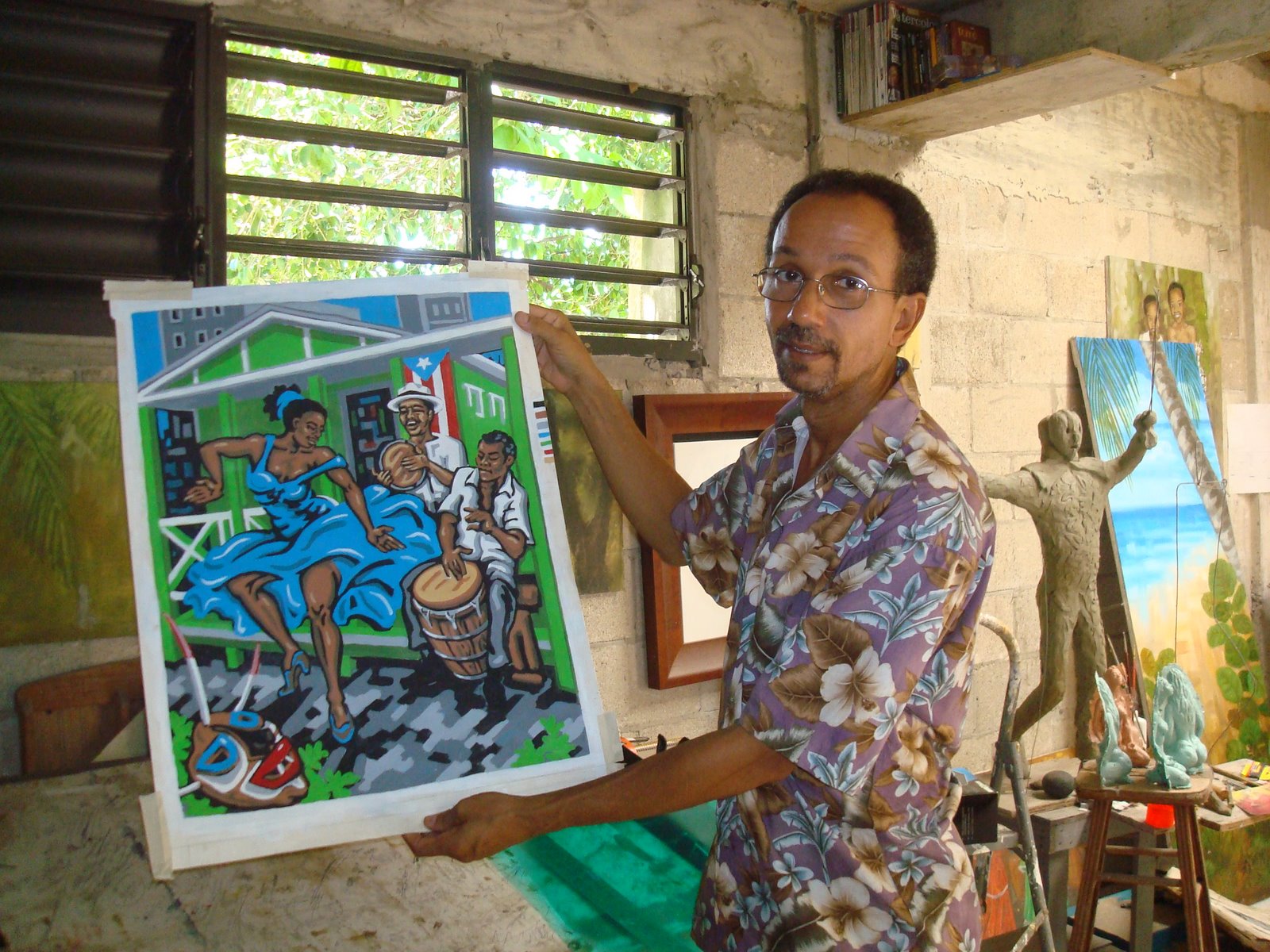
Author Lola Rosario, left, with legendary bomba dancer Raquel Ayala, Loíza, Puerto Rico. (Courtesy of Lola Rosario)
LOÍZA, Puerto Rico — Situated in the northeast region of Puerto Rico, Loíza has for decades captivated visitors. Affectionately labeled the “Capital of Tradition,” this coastal town is widely known for mouth-watering seafood, seemingly endless shorelines, and its spectacular annual week-long festival honoring Saint James.
And while many tourists venture outside of Old San Juan to experience the abundantly colorful sights and sounds this pueblo offers, they’ve only recently begun to see what loiceños have understood for generations: Loíza’s undisputed role as the mecca of Afro-Puerto Rican culture.
It is here, at the intersection of art and music, that we find two of the town’s most celebrated icons: bomba dancer Raquel Ayala and renowned painter and sculptor Samuel Lind.
The Matriarch Carries More Than a Family
Raquel Ayala has always had a passion for dance. As a young child listening to Cheo Feliciano and Ismael “Maelo” Rivera, Ayala —who says salsa was her first love— knew music to be an intrinsic part of her being. Innovating her unique style, she flowed freely to those radio tunes her parents played in their humble home.
At the tender age of seven, she started learning to dance bomba, one of Puerto Rico’s traditional folk genres where call-and-response forms the backdrop of an impassioned conversation between subidor (main drummer) and bailador (dancer). Back then, her father, Don Castor Ayala, began forming what would become the family’s musical legacy, the Ballet Folclórico Los Hermanos Ayala de Loíza (Ayala Folkloric Ballet of Loíza).
“Being the youngest at the time, the group consisted of my sister Celia and my brothers Marcos and Rubén. Father said I couldn’t be a part of the group until I was older,” Ayala recalled. “Later, when my older siblings married and after Celia had already moved to Boston, it was only me, my nephews and nieces who remained. I was 15.”
By 1959, Don Castor officially founded the dance company as a cultural non-profit organization. Raquel continued fine-tuning her craft as the group’s principal female dancer. In time the group would be offered numerous opportunities to bring bomba to other shores.
Traveling internationally to México, the Dominican Republic, Perú, and throughout the East Coast of the United States, the Ayalas showcased Puerto Rico’s vibrantly rich heritage. Their performing in festivals and participating in television and travel channel documentaries allowed bomba to reach a much wider audience.
Today, more than 60 years later, Loíza’s bomba tradition continues. And while Raquel Ayala’s legacy as matriarch remains unquestioned, it goes beyond that of her bloodline. Though she is retired from traveling with the dance troupe her father created, she remains active in their rehearsals , as an observer and educator.
Reflecting on what she sees in children learning to dance, she said: “The children who come here are very excited to learn the music and the dance. I remind them that each of us has our own style and unique flavor. The point is not to dance like me.”
Turning serious for a moment, she added: “Bomba is about hand movements, arm gestures, and footwork. When they start doing ‘shake-y shake-y’ with their shoulders, that’s where I draw the line. Because that’s rumba, not bomba.”
When not overseeing one of the group’s practice sessions, she can be found on her porch playing dominoes with younger sister Linda. Otherwise, she’s sometimes seen entertaining tourists with her magnetic personality and infectious laughter.
True to her calling, Raquel is quick to offer a tip to anyone eager to learn a few bomba moves.
Raising Consciousness Through Cultural Artistic Expression
Tucked away on a quiet street in Mediania Alta lies the three-story space serving as a working art studio and home to one of Loíza’s treasured children, painter and sculptor Samuel Lind. Arriving here is to grab a glimpse of what this town looked like decades ago , with its expansive palm groves and verdant landscapes.
Though much has changed, Lind still draws inspiration from those childhood memories of the town’s idyllic coastal beauty, and he continues to capture vivid cultural scenes in his work. Having been raised in a heavily fishing-dependent community, Samuel’s work represents natural panoramas at risk of disappearing.
When asked about the role his work plays in a changing world where real estate development takes priority over the environment, he becomes pensive.
“From the first moment I saw images emerge in my work, I began to understand my responsibility,” he said. “For me, the main mission was to create awareness. Apart from the need for personal artistic expression, I realized those images depicting simple Puerto Rican lifestyles carried a message — that our lives and our culture were worth exalting. It was [and remains] very important that I depict scenes of loiceño life.
“Seeing what was happening to our neighborhoods, the destruction of palm groves, and the displacement of people to build condominiums, that hurt. To see our environment drastically change was to lose a part of me,” he added.
Art as a Vehicle for Resistance and Connection With the Youth
Although Lind’s work has been showcased internationally — in Chile, Japan, México, and the U.S. — he has chosen to remain in his beloved Loíza. Several times throughout his career, his ears have met with two particular criticisms, such as the notion of creating “primitive art that won’t sell” and the recommendation to leave his hometown in order for his “work to progress”—perspectives he refuses to accept.
“My art is full of daily experiences, portraying a segment of la vida del puertorriqueño (Puerto Rican lifestyle),” he said. “Some have called it ‘primitive’ as if to say my paintings are too ‘homely’ and simple. They said it wouldn’t sell. The irony is I’ve sold many paintings of these images to people who find this bold ‘old Loíza’ landscape grounding. I’ve been told they find healing in my work.”
As for the idea that he should leave his native Loíza to advance his work, he explained: “For them, ‘progress’ meant I needed to paint other panoramas. More significantly, they insisted it meant leaving Loíza behind. It was a lie. Ever since I painted Guillermo y su Palmar (Guillermo in His Palm Grove), I understood that the environment here is inextricably connected to nature. As loiceños, nature is a part of our essence.”
In both scenarios, Lind is acutely aware of his art as resistance, and he is completely comfortable with it.
Aside from being an advocate for protecting our natural resources and the environment, his commitment to the youth is palpable. Through workshops, school visits to his studio, and mentorship programs, he aims to instill respect and connection to nature and Loíza.
For Lind, it goes beyond simply showing them his work.
“I see the youth as a continuity of the present and tomorrow. The future is theirs, and they are not oblivious to their role in society,” he said. “Consider this: When the younger generations are surrounded by limited possibilities, they start to believe what others tell them—that they have no future.
“This creates in them a yearning for the truth. When kids visit my studio or participate in smaller community workshops, I observe them. I avoid lecturing — they probably already get that at home or from teachers. Rather, I listen to their perspectives on what they see in my studio as well as what they’re doing in their lives , whether it’s painting, playing an instrument, writing, or other creative venture,” Lind said.
He also shared why he’s so connected to the younger generation.
“They’re open and curious,” he explained. “I always tell them if they’re passionate about their work, continue that route, surround themselves with supportive people, build networks, and build a defined plan. I always remind them not to let anyone tell them they can’t do something.”
For Samuel Lind, it’s about allowing these youngsters (many of them teens) to see possibilities rather than obstacles. Calling to mind other creatives from Loíza —such as film producer Roxana Quiñonez Villalobos , actor Modesto Lacen, mixed media artist Celso González Quiñones, and painter Daniel Lind Ramosm to name a few— Lind recognizes the relatability factor.
“When they see people like us , who look like them and come from the same pueblo , they begin to see that doors do open,” he explained. “They begin to foster pride in their identity and in our culture.”
***
Lola Rosario is an Afro-Boricua poet and cultural storyteller based in Loíza, Puerto Rico. Twitter: @lola_declama

